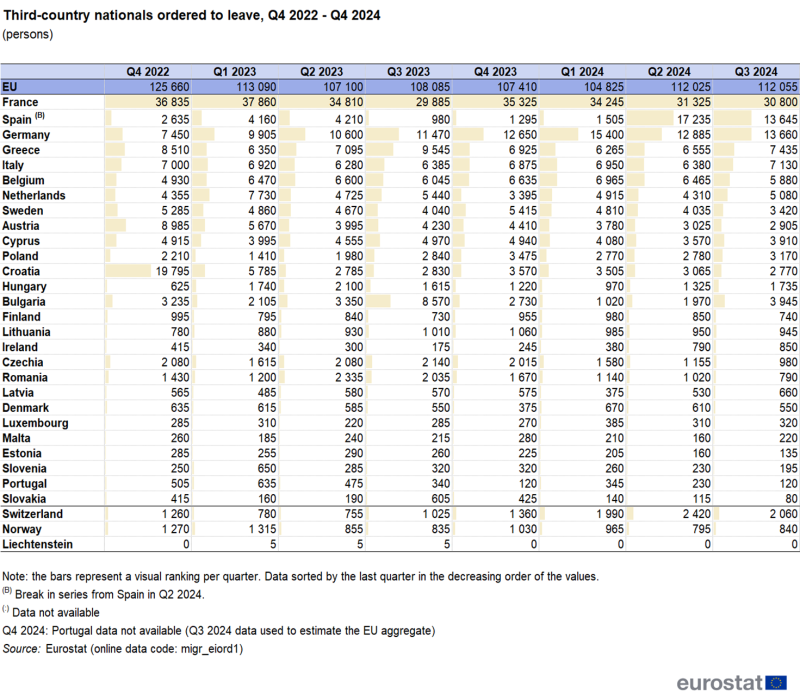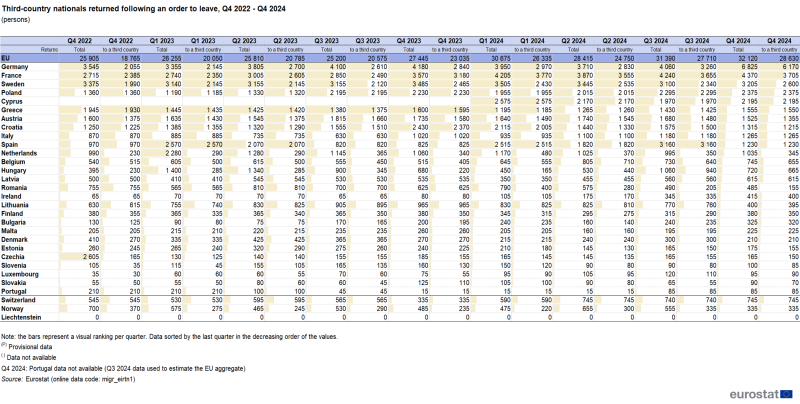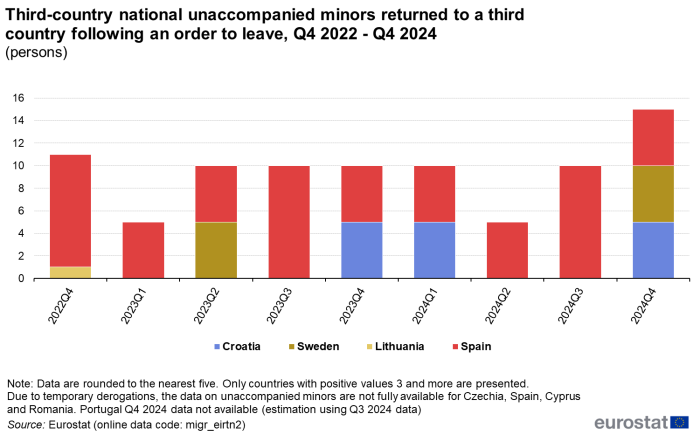Data extracted on 18 March 2025
Planned article update: 30 June 2025
Highlights
124 935 non-EU citizens were ordered to leave the territory of an EU country in Q4 2024, an increase of 16.3% compared with the same period of 2023.
In Q4 2024, 28 630 persons were returned to a third country, an increase of 24.3% compared with the same period of 2023.
Third-country nationals ordered to leave and returned following an order to leave, EU, Q4 2022 - Q4 2024
This article presents the latest developments for 2 indicators on the enforcement of immigration legislation. It shows quarterly statistics on non-EU citizens who were ordered to leave the territory of an EU country [1] and those who were effectively returned following an order to leave.
Non-EU citizens ordered to leave
In Q4 2024, the total number of non-EU citizens ordered to leave the territory of an EU country was 124 935 (Table 1), an increase of 11.5% compared with the previous quarter, and an increase of 16.3% compared with Q4 2023. Among the EU countries, France reported the largest number of persons ordered to leave (31 880, 25,5%), followed by Spain (18 645, 14,9%) and Germany (15 135, 12,1%). These 3 EU countries altogether accounted for more than half (52.5%) of all third-country nationals ordered to leave during Q4 2024.

Source: Eurostat (migr_eiord1)
In Q4 2024, the top 5 countries of citizenship of third-country nationals ordered to leave were Algeria (11 360), accounting for 9.1% of the total, followed by Syria (8 675, 6.9%), Morocco (8 560, 6.9%), Afghanistan (7 195, 5.8%), and Türkiye (6 615, 5.3%) (Figure 1). Compared with the previous quarter (Q3 2024), there was an increase in the number of orders to leave for nationals of Afghanistan (29.0%), Syria (17.5%), Morocco (7.1%), Algeria (6.1%), and Türkiye (3.2%).
Compared with the same quarter of 2023, the number of orders to leave issued in Q4 2024, significantly increased for Syrians (47.3%), Algerians (46.9%), and Afghans (29.4%). Smaller increases were observed for Moroccans (3.9%) and Turks (0.5%).
Returns of non-EU citizens
In Q4 2024, 28 630 non-EU citizens who received an order to leave an EU country were effectively returned to a third country i.e. outside of the EU. This represents an increase of 24.3% compared with the same quarter of 2023 (Table 2). Germany (6 170, 21.6% of total returns a third country), France (3 705, 12.9%) and Sweden (2 600, 9.1%) reported the highest numbers of third-country nationals returned outside of the EU in Q4 2024, accounting for 43.6% of the total number of returns. The returns to a third country amount to 89.1% of total returns (32 120), which also include readmissions between EU/EFTA countries. This share has slightly increased compared with the previous quarter (87.7%) and Q4 2023 (83.9%).

Source: Eurostat (migr_eirtn1)
Georgians (3 350) were the top non-EU citizenship returned outside EU in Q4 2024), followed by Turks (2 490), Albanians (1 980), Moroccans (1 145) and Moldovans (1 045) (Figure 2).
Compared with the previous quarter, there was an increase of the returns to a third country of citizens from Morocco (32.8%), Türkiye (25.9%), Georgia (12.0%), while for citizens from Moldova (-11.2%) and Albania (-1.7%) the number of returns to a third country has decreased. When comparing with Q4 2023, the number of returns to a third country increased for Moroccans (33.1%), Turks (30.1%), Moldovans (20.2%) and Georgians (8.7%), while a decrease was observed for Albanians (-0.9%).
Types of returns and assistance received
At EU level, more than half of returns (57.1%) to a third country concerned people who left the territory voluntarily, while 42.9% concerned forced returns (Figure 3). However, the proportion of voluntary returns versus enforced returns varies significantly among the EU countries. In Romania and Italy all the returns reported were enforced, while in Estonia, Latvia, Denmark and Lithuania, more than 90% of reported returns were recorded as voluntary.
In Q4 2024, 76.3% of returns to a third country were assisted and 23.7% were non-assisted (Figure 4). The proportion of assisted returns versus non-assisted returns varies significantly among the countries. In Belgium, Denmark, Germany, Cyprus, Spain, Italy, Portugal and Romanian all reported returns of non-EU citizens outside an EU or EFTA country were assisted, while more than 90 % of all third-country nationals leaving Latvia and Lithuania were non-assisted.
Unaccompanied minors ordered to leave the EU and those returned following an order to leave
In Q4 2024, 675 orders to leave the EU territory were issued to unaccompanied minors, an increase of 0.9% in comparison with the third quarter of 2024. Greece (520), followed by The Netherlands (65) and Croatia (30) issued the highest number of orders to unaccompanied minors to leave the EU territory (Figure 5). Nearly three quarters of the unaccompanied minors ordered to leave were for citizens from Afghanistan (255), Somalia (140) and Syria (85).

Source: Eurostat (migr_eiord2)
In Q4 2024, based on the available data, 25 unaccompanied minors who received an order to leave an EU country were returned to a third country. Croatia (15), Lithuania, Spain and Sweden (5 each) reported the highest number of unaccompanied minors returned following an order to leave their territory. The unaccompanied minors returned to a third country were mainly from Türkiye (15) and Colombia (5).

Q4 2022 - Q4 2024
Source: Eurostat (migr_eirtn2)
Source data for tables and graphs
Data sources
Statistics on the enforcement of immigration legislation are based on administrative data provided by national authorities in line with the requirements of Regulation (EC) No 862/2007 concerning statistics on migration and international protection. The compilation of these statistics draws on the terms used by the Schengen Borders Code, an EU code on the rules governing the movement of persons across borders (Regulation (EU) No 2016/399); for more information on the Schengen area, see here.
Statistics on the enforcement of immigration legislation exclude outgoing asylum seekers who are transferred from one Member State to another under the mechanism established by the Dublin Regulation (Regulation (EC) No 1560/2003 and Regulation (EU) No 604/2013); these cases are covered by Dublin statistics.
Note that the data presented in this article are rounded to the nearest five. Due to the rounding, various totals (such as for the EU) may not necessarily match the sum of the values for their components (such as the sum of values for the EU countries).
Data on unaccompanied minors ordered to leave and returned following an order to leave are not available for Portugal. Due to temporary derogations, the data on unaccompanied minors for both collections are not fully available for Czechia, Spain, Cyprus, the Netherlands and Romania. As a result, these EU countries were not included in the calculation of the respective EU totals.
Spain adopted a broader definition on return decisions, which leads to a time series break.
The statistics presented in this article consider the derogations granted to Member States from 2021 to 2023 based on Commission Implementing Decision (EU) 2021/431 of 10 March 2021 (see article Enforcement of immigration legislation statistics introduced)
Note that due to differences in national administrative procedures in migration law enforcement and methodological aspects related to compilation of data in this area, the number of persons returned in a given quarter shall not be directly related with the number of persons ordered to leave in the same reference period, e.g. a person can be ordered to leave in Q4 of year N, but effectively returned in Q1 of year N+1.
Context
The enforcement of migration law refers to 2 main subjects: controlling the EU’s external borders and the management of unauthorised non-EU citizens found on the territory of an EU country. Control of the EU’s external borders constitutes one of the pillars for the creation of a freedom, security and justice area. The most noteworthy developments concern a harmonised set of rules governing the movement of persons across borders (the Schengen Borders Code published by Regulation (EU) No 2016/399); a comprehensive approach for European integrated management at the EU’s border and efficient and effective management of border crossing and EU returns policy, respecting fundamental rights, and safeguarding free movement, operated by the European Border and Coast Guard Agency (Regulation (EU) No 2019/1896); an extensive package on automated border control was introduced (namely the Entry-Exit System established by (namely the Entry-Exist System established by the Regulation (EU) No 2017/2225 and Regulation (EU) No 2017/2226, and the European Traveler Information and Authorisation System established by Regulation (EU) No 2018/1240 and Regulation (EU) No 2018/1241).
The management of irregular migrant populations involves the finding of illegally present persons, the recognition of a decision of an order to leave and the effective return. The main legal instrument, the so-called Return Directive (Return Directive (2008/115/EC)), came into force at the end of 2010 establishing common standards for returning non-EU citizens illegally staying in the EU. The EU also aims to promote a more effective return system (Policy Document Towards an Operational Strategy for more Effective Returns - COM/2023/45 Final), aimed at achieving, as an operational goal, among others, the improvement of data and statistical evidence-based on return, building a more targeted, planned and efficient return policy, and a common operational response capability.
Several Schengen Area member countries have (temporarily reintroduced) the border control at internal borders pursuant to Article 25 and 28 et seq. of the Schengen Borders Code (with several reasons, for instance significant high pressure of irregular migration flows, smuggling and trafficking of human beings, secondary movements; organised criminal and terrorism threats; relevant events that could enhance migration flows and or criminal or terrorism threats).
Regarding measuring the enforcement of immigration legislation, Regulation (EC) No 2020/851 amended Regulation (EC) No 862/2007, established a framework for a quick response to changing needs regarding statistics on migration and international protection (in particular Articles 5 and 7). It also commits to data collection on a sub-annual basis in order to respond to the main needs for study, formulation and evaluation of migration and developing human-rights-based policies, and enhancing the knowledge of migration and international protection and migratory movements within European Union countries
Footnotes
- Statistics on the enforcement of immigration legislation refer to the concept of external borders for all EU countries and EFTA countries, even if some of these are not in the Schengen area. The external borders of the Schengen area do not coincide with the external borders of the EU countries due to: opt-outs for Ireland from the Schengen area; Bulgaria, Cyprus are not yet member of the Schengen area; Bulgaria and Romania are Schengen area members since 31 March of 2024, but maintaining the border control on land borders; Iceland, Liechtenstein, Norway and Switzerland are part of the Schengen area but are not members of the EU. ↑
Explore further
Other articles
Database
- Enforcement of Immigration Legislation (migr_eil)
- Third-country nationals refused entry at the external borders - annual data (rounded) (migr_eirfs)
- Third-country nationals found to be illegally present - annual data (rounded) (migr_eipre)
- Third-country nationals ordered to leave - annual data (rounded) (migr_eiord)
- Third-country nationals ordered to leave by citizenship, age and sex - quarterly data (rounded) (migr_eiord1)
- Third-country unaccompanied minors ordered to leave, by citizenship, age and sex of the minor – quarterly data (rounded) (migr_eiord2)
- Third-country nationals returned following an order to leave - annual data (rounded) (migr_eirtn)
- Third-country nationals returned following an order to leave, by type of return, citizenship, country of destination, age and and sex – quarterly data (migr_eirtn1)
- Third-country unaccompanied minors returned following an order to leave, by type of return, citizenship, country of destination, age and sex of the minor – quarterly data (rounded) (migr_eirtn2)
- Third-country nationals who have left the territory by type of return and citizenship (migr_eirt_vol)
- Third-country nationals who have left the territory by type of assistance received and citizenship (migr_eirt_ass)
- Third-country nationals who have left the territory to a third country by type of agreement procedure and citizenship (migr_eirt_agr)
- Third-country nationals who have left the territory to a third country by destination country and citizenship (migr_eirt_des)
- Returns by type of return - % of total returns (migr_eilretpc)
- Persons subject to immigration law enforcement - per thousand persons (migr_eilpop)
Thematic section
Methodology
- Enforcement of Immigration Legislation (ESMS metadata file — migr_eil_esms)
External links
Legislation
Return legislation
- Communication COM(2004) 412 final of 4 June 2004: Study on the links between legal and illegal migration
- Communication (COM(2018) 250 final of 14 March 2018: Progress report on the Implementation of the European Agenda on Migration
- Directive2008/115/EC on common standards and procedures in Member States for returning illegally staying third-country nationals
Legislation on migration and international protection statistics
- Regulation (EU) 2020/851 of the European Parliament and of the Council of 18 June 2020 amending Regulation (EC) No 862/2007 on Community statistics on migration and international protection
- Commission Implementing Decision (EU) 2021/431 of 10 March 2021 granting derogations to certain Member States from Regulation (EC) No 862/2007 of the European Parliament and of the Council on Community statistics on migration and international protection (notified under document C(2021) 1490) (Only the Croatian, Czech, Dutch, French, German, Greek, Italian, Lithuanian, Maltese, Polish, Portuguese, Romanian, Slovak, Spanish and Swedish texts are authentic)
Other Enforcement Immigration Legislation
- Regulation (EU) 2019/1896 of the European Parliament and of the Council of 13 November 2019 on the European Border and Coast Guard and repealing Regulations (EU) No 1052/2013 (EUROSUR) and (EU) 2016/1624 (European Border and Coast Guard)
- Regulation (EU) 2016/399 of the European Parliament and of the Council of 9 March 2016 on a Union Code on the rules governing the movement of persons across borders (Schengen Borders Code)
- Regulation (EU) 2017/2226 of the European Parliament and of the Council of 30 November 2017 establishing an Entry/Exit System (EES) to register entry and exit data and refusal of entry data of third-country nationals crossing the external borders of the Member States and determining the conditions for access to the EES for law enforcement purposes, and amending the Convention implementing the Schengen Agreement and Regulations (EC) No 767/2008 and (EU) No 1077/2011
- Regulation (EU) 2018/1860 of the European Parliament and of the Council of 28 November 2018 on the use of the Schengen Information System for the return of illegally staying third-country nationals
